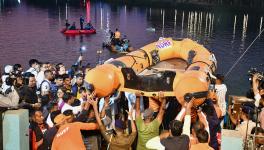Displaced, Not Erased: Videos Record History of Narmada Struggle

Image Courtesy: Oral History Narmada
On June 4 this year, the water level in the Sardar Sarovar Dam on the Narmada River was 121.48 metre, the full capacity of the dam is at 138.68 metre. On June 18, even as the monsoon had just reached Gujarat, the dam had filled to 127 m, just 11 m short of full capacity. The 30 big, 135 medium and 3,000 small dams of this project have reservoirs that span across once fertile villages in Gujarat, Maharashtra and Madhya Pradesh. The Sardar Sarovar Project alone displaced 245 villages. An online portal now attempts to record the history of that struggle.
Oralhistorynarmada.in brings together narratives from people who witnessed the laying of the project’s foundation stone and were among those evicted from lands they occupied for generations. More than half the nearly 2.5 lakh people displaced by the project were tribals, and had sought land in compensation for land lost. That was impossible to grant. In its order in the year 2000, giving the go ahead to the construction of the project, the Supreme Court had ruled that those who were evacuated would be resettled and rehabilitated “satisfactorily” by the three state governments.
Only those who lived in the submergence area of the dam were considered project affected people (PAP); those displaced by the colonies and canals that came up as supporting infrastructure were not considered project affected, and received only meagre cash compensation.
Justice SP Bharucha wrote in his dissenting judgement in the SC order, “Notes prepared by the Ministry of Water Resources and the Ministry of Environment and Forests leave no manner of doubt that the requisite data for assessment of environment impact of the project was not available when the environment clearance thereof was granted.”
Ushaben Tadvi of Vadagam village on the banks of River Narmada in Gujarat, the first village flooded by the Sardar Sarovar Project, remembers how things were before the dam. In a video on the oral history site, she says, “When the children were sick, we used plants and trees that grew in the area to extract medicines for them. And they got better, there was no need for the expensive treatment that we now are forced to get, which pushes us to debt. We lived a life of peace, there was enough water – we bathed and washed clothes in the Narmada, these days (in the resettlement colony at Dharampuri) we bathe out of a bucket. We only had to throw seeds on the ground and they would sprout, it was organic, that farming. These days, we need to provide water and fertiliser, and even then the crop is not healthy.”
She says the katcha (mud) houses of the village were better – there was no need for expensive paint on the walls, they could just use a coat of mud. They looked good without any expensive maintenance. In the pucca houses, even painting the walls is an expense; it is not as if colour comes free.
Ushaben recalls how she could travel often from the home of her husband to that of her mother – she could even just take a walk back to her maternal home. From the resettlement site, though, a trip back to her mother’s house would cost at least Rs 500. She goes once in two or three years, she says, and the last time she visited was when there was a death in the family.
Pervi of Jalsindhi village in Madhya Pradesh’s Alirajpur district says, “The jungle is our father, the river our mother. When the river was free-flowing, the animals too were happy. They returned unharmed after drinking water from the river. Once the dam construction began, the area near the banks became marshy. Animals would get stuck. I lost a cow and a buffalo like that. There were also crocodiles that would prey on the animals.”
She misses not just the fruit trees and houses that were submerged, but also the leopards and bears, her neighbours. “The river has been choked, the dam is like a noose around her neck,” she says. The Narmada Bachao Andolan, which initially sought proper rehabilitation of those displaced, also questions the very paradigm of development represented by these large projects, giving voice to the concerns of women like Pervi.
Video recordings of these interviews were collected by Nandini Oza, an activist with Narmada Bachao Andolan, who compiled them together into the website in November last year. “There is an old African saying: ‘Until the lions have their own histories, the history of the hunt will glorify the hunter’. In the context of “development” too, unless the victims narrate their histories, development planners will glorify the project, even if it means taking liberties with the truth. The website is an attempt to ensure these narratives too are out there,” she said. Oza is currently the president of the Oral History Association of India, set up in 2013 as a professional group to preserve aspects of culture and history that do not get representation in mainstream narratives.
Shantaben Yadav of Pipri in Madhya Pradesh, who was among seven people who sat on an indefinite fast in 1990 to protest the project, says, “Our culture was destroyed, the valley is gone. Omkareshwar, Maheshwar… such large dams, the river is immortal. It never dried even in the worst drought, but now its water has been dammed. The Shulpaneshwar forest was such a rich resource, it’s gone. These decisions are taken in Mumbai and Delhi…”
Eighty-three-year-old Dalsukhbai Tadvi was a young man in 1961 when the foundation stone of the project was laid by Prime Minister Jawaharlal Nehru. He remembers working as a labourer with those who had arrived to survey the land and take measurements. He would help in carrying their equipment and clearing foliage so measurements were accurate. He remembers he was paid Rs 1.50 for each day’s work, as daily wages. He remembers the time that the prime minister arrived by helicopter and spoke to the people in Hindi. “These days, even what is written could be a lie. In those days, truth was the norm. We had no reason to disbelieve the prime minister when he told us that our lands were needed for the project, and we would be moved elsewhere. We thought we would get other land. We trusted him,” he says, remembering how vast numbers had gathered from nearby villages, arriving by boat as there was no other way to cross the river in those days.
Compensation offered to those losing their lands was meagre, just Rs 60-100 for an acre, when acquisition began in the 1960s. “Land was taken for the price of salt,” says Dalsukhbai.
Muljhibai Tadvi who comes from a family that lived for generations in Kevadia, where the dam now stands, remembers how the blasting work began in 1962, shortly after Nerhu arrived and laid the foundation stone. Villagers who were not given land in compensation for land lost also began their protests around this time, submitting petitions and witnessing the sharp differences that cropped up between the state governments, delaying work on the project. To adjudicate on the sharing of river water between states, a tribunal was set up in 1969.
“(Prime Minister) Morarji Desai used a lot of tricks to get the three states to come to an agreement,” Tadvi says. While Indira Gandhi was prime minister, the states wrangled about the submergence area and their share of water; when Desai became PM in 1977, the matter gained momentum and the tribunal awarded a decision in 1979.
Translating from Desai’s biography that appeared in Gujarati, Nandini Oza writes: “Indira Gandhi...Though the Prime Minister had promised to bring about a speedy solution, there was no solution till the year 1974. As opposed to this, she withdrew this issue from the tribunal and kept it unresolved and submitted this issue once again to the tribunal in the end of the year 1974. This is how the judgment was delayed for no reason at all. That one of the two states will have to be displeased and so decision is not being taken is what she had said. But she should have understood this from the very beginning. She should not have promised the people of Gujarat an early decision in the matter.”
Muljhibai Tadvi explains how the villagers got together and approached the court but they were tired out – they would have to travel long distances from the village each time for a hearing, and then they would end up just waiting in the court. The lawyers’ fees and the expenses incurred on the travel seemed, in the end, not worth it.
Over 70 years after it was envisaged, the project has failed to fulfil the irrigation water needs that it was initially meant to serve. Gujarat was meant to get high irrigation benefits, so the water disputes tribunal awarded it only 16% of the power generated from the project. However, the state has used water for industrial and domestic use; irrigation needs remain unmet and the drought-prone Kutch and Saurashtra districts are still largely dependent on rain for agriculture.
For students of history, law, development or environment studies, the videos of the interviews offer glimpses into how ordinary Indians peacefully negotiate with the state for their rights and for the environment, and how institutions repeatedly fail them.
The writer is an independent journalist. The views are personal.
Get the latest reports & analysis with people's perspective on Protests, movements & deep analytical videos, discussions of the current affairs in your Telegram app. Subscribe to NewsClick's Telegram channel & get Real-Time updates on stories, as they get published on our website.
























